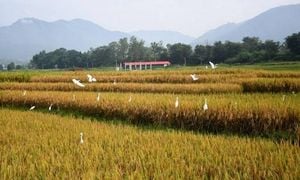In a dramatic show of force and coordination, the Kenya Navy recently intercepted a stateless dhow, codenamed IGOR, in a massive anti-narcotics operation that has drawn both national and international attention. The vessel, found 630 kilometres east of the Mombasa coast on October 26, 2025, was carrying a staggering 1,024 kilograms of methamphetamine. Authorities estimate the street value of the seized drugs at approximately Ksh8.2 billion, making it one of the largest maritime drug hauls in Kenya’s history, according to People Daily and The Kenyan DAILY POST.
The operation, codenamed BAHARI SAFI 2025.01, was led by the Kenya Navy under the Safe Seas Africa (SSA) Programme. Kenya Navy Ship (KNS) Shupavu was deployed for the mission, which was anything but routine. The IGOR dhow had long been under the watchful eyes of international drug enforcement agencies, having reportedly slipped past several previous crackdowns. This time, however, the net closed tightly, thanks to a multi-agency effort that spanned several countries and organizations.
Brigadier Sankale Kiswaa, Deputy Commander of the Kenya Navy and the multi-agency team leader, confirmed the details of the operation. "The Kenya Navy successfully intercepted a vessel of interest codenamed IGOR suspected of involvement in narcotics trafficking," he stated, as reported by The Kenyan DAILY POST. The operation’s success, he emphasized, was a testament to the effectiveness of regional cooperation in combating transnational crimes in the Western Indian Ocean.
The scale and sophistication of the IGOR interception were made possible by extensive coordination with a trio of regional partners. The Regional Coordination Operations Centre (RCOC) in Seychelles, the Regional Maritime Information Fusion Centre (RMIFC) in Madagascar, and the Republic of Seychelles itself played crucial roles. Maritime surveillance was provided through Maritime Patrol Aircraft (MPA) from Seychelles, allowing authorities to track and ultimately corner the elusive dhow. Once intercepted, KNS Shupavu escorted the vessel and its crew to Mombasa port, where a multi-agency team took custody of the six foreign nationals on board for further investigation and prosecution. Court warrants for additional inspection and testing of the evidence have already been obtained, officials said.
This recent operation is not an isolated incident but rather the latest in a series of high-profile maritime drug seizures in Kenyan waters. The Kenya Navy has a storied history of intercepting massive drug shipments, with several notable cases in the past decade. In August 2014, for instance, the Navy intercepted the MV Al Noor off the coast of Mombasa. Hidden within the vessel’s fuel tanks, officers discovered 370.8 kilograms of heroin valued at Ksh1.4 billion. The drugs were concealed in the ship’s 1,800-liter diesel reservoir, and the bust occurred off the Kenyan coast in Lamu. In a dramatic gesture meant to send a clear message to traffickers, President Uhuru Kenyatta ordered the public destruction of the MV Al Noor at sea, an act widely covered by local media at the time.
International cooperation has also played a vital role in these efforts. In April 2014, the Royal Australian Navy frigate HMAS Darwin intercepted a dhow carrying over one tonne of heroin off the coast of Mombasa. Although not a Kenya Navy-led operation, this interception underscored the significance of the East African maritime route for large-scale heroin consignments and the necessity for cross-border collaboration. As People Daily pointed out, these operations highlight the relentless use of the region’s waters by international drug syndicates and the growing need for coordinated responses.
Despite these successes, challenges remain. Gaps in coordination and enforcement persist, sometimes allowing traffickers to exploit weaknesses in maritime oversight. Nyali MP Mohammed Ali has been vocal about the need for greater transparency and accountability in handling seized vessels and narcotics. He has called for the public destruction of intercepted ships to prevent the possibility of drugs finding their way back into circulation. Ali has also criticized the Ministry of Blue Economy for delays in implementing seafarer recruitment plans and issuing identification documents, arguing that such inefficiencies can inadvertently aid criminal networks.
"We must ensure these vessels are destroyed in public view to send a strong message and guarantee the drugs do not end up back in the wrong hands," Ali said, echoing concerns that have been raised repeatedly by anti-narcotics advocates and lawmakers. His calls for reform have gained traction, especially in light of the IGOR operation, which has reignited public debate over maritime security and the fight against drug trafficking.
The Safe Seas Africa (SSA) Programme, under which the BAHARI SAFI 2025.01 operation was conducted, is part of a broader regional initiative to enhance maritime security. By fostering information sharing and joint operations among countries bordering the Western Indian Ocean, the SSA aims to close loopholes that traffickers have historically exploited. The involvement of organizations such as the RCOC and RMIFC, along with direct support from Seychelles, demonstrates a growing recognition that no single nation can tackle the problem alone.
For the Kenya Navy, the interception of IGOR is both a victory and a reminder of the ongoing battle against drug trafficking. The operation’s success has been widely praised, but it also highlights the persistent threat posed by well-funded and highly organized criminal syndicates. The use of stateless vessels, sophisticated concealment methods, and international smuggling networks makes the task daunting. Yet, as the events of October 26, 2025, show, determined and coordinated action can yield significant results.
Looking back at previous cases, it’s clear that each major bust has contributed valuable lessons. The destruction of MV Al Noor set a precedent for dealing with seized vessels, while the HMAS Darwin operation showcased the benefits of international naval cooperation. The IGOR interception, with its record-setting methamphetamine haul, now stands as a new benchmark in Kenya’s maritime anti-narcotics efforts.
As investigations continue and the six suspects face prosecution, attention is turning to what comes next. Will the IGOR dhow meet the same fate as MV Al Noor? Will the lessons learned from this operation lead to lasting improvements in maritime security and drug enforcement? These are questions that policymakers, law enforcement agencies, and the public are all grappling with.
For now, the Kenya Navy’s actions have sent a strong signal to traffickers operating in the region. With regional partnerships strengthening and political will mounting, the fight against maritime drug trafficking in the Western Indian Ocean is entering a new phase—one marked by vigilance, cooperation, and an unwavering commitment to keeping Kenya’s shores safe.



